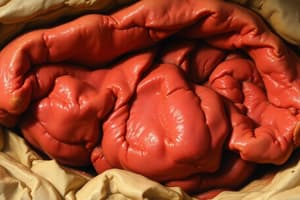Podcast
Questions and Answers
What role does shellac wax play in dental technology?
What role does shellac wax play in dental technology?
- It acts as an adhesive for dental restorations.
- It serves as a coating for dental impressions.
- It is integral in the production of (partial) dentures. (correct)
- It is primarily used for polishing dental tools.
Which component is NOT a derivative of simple lipids as mentioned?
Which component is NOT a derivative of simple lipids as mentioned?
- N2-base
- Phosphate
- Cholesterol (correct)
- Protein
Which of the following is considered a polar head group in complex lipids?
Which of the following is considered a polar head group in complex lipids?
- Fatty acid
- N2-base
- Phosphate (correct)
- Glycerol
What characteristic makes complex lipids different from simple lipids?
What characteristic makes complex lipids different from simple lipids?
Which element is included as an additional group in the structure of complex lipids?
Which element is included as an additional group in the structure of complex lipids?
What form of energy is primarily stored in adipose tissues?
What form of energy is primarily stored in adipose tissues?
Which statement accurately describes the function of fat under the skin?
Which statement accurately describes the function of fat under the skin?
What is the main advantage of storing fat as triglycerides in the skin?
What is the main advantage of storing fat as triglycerides in the skin?
Where is the major storage site for fat in the body?
Where is the major storage site for fat in the body?
Which feature of adipose tissue contributes to its role as a thermal insulator?
Which feature of adipose tissue contributes to its role as a thermal insulator?
Flashcards are hidden until you start studying
Study Notes
Adipose Tissue and Energy Storage
- Adipose tissue is the primary storage site for fat in the body, primarily in the form of triglycerides.
- Adipose tissue is also found in the skin, where it acts as a thermal insulator against cold.
- Shellac wax is used in dentistry, particularly for partial denture production.
Complex Lipids
- Complex lipids are derived from simple lipids and contain additional groups like phosphate, nitrogenous bases, and proteins.
- Complex lipids have both hydrophilic (polar head) and hydrophobic (glycerol) components.
- In diabetes mellitus, the metabolism of fatty acids and lipoproteins is disrupted, leading to ketosis.
Clinical Significance of Lipids
- Lipids play crucial roles in various biological processes.
- Structural Components: Lipids form cell membranes and myelin sheaths, providing structural integrity.
- Energy Storage: Triglycerides are the major energy storage form in the body.
- Hormones: Some hormones, like steroid hormones, are derived from lipids.
- Insulation: Subcutaneous fat acts as a thermal insulator.
Proteins
- Proteins are complex macromolecules made up of amino acids linked by peptide bonds.
- Proteins have diverse functions in the body:
- Transport: Hemoglobin transports oxygen in the blood.
- Enzymes: Catalyze chemical reactions within the body.
- Defense: Immunoglobulins (antibodies) provide immune defense.
- Hormones: Insulin and other hormones regulate various bodily functions.
- Structural Components: α-keratin is found in hair and epidermis, providing structural support.
Nucleic Acids
- Nucleic acids are essential biomolecules that carry genetic information in living organisms.
- Two main types of nucleic acids:
- Deoxyribonucleic Acid (DNA): Carries the genetic code for protein synthesis and inheritance.
- Ribonucleic Acid (RNA): Involved in protein synthesis, translation, and gene regulation.
- Location of nucleic acids:
- Eukaryotic Cells: Nucleus, mitochondria, chloroplasts.
- Prokaryotic Cells: Cytoplasm (not enclosed within membranes).
Nucleic Acid Monomers
- DNA and RNA are made up of monomers called nucleotides.
Studying That Suits You
Use AI to generate personalized quizzes and flashcards to suit your learning preferences.



